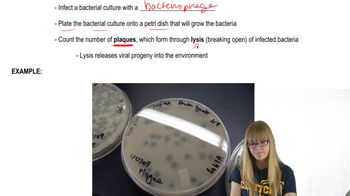If a DNA sequence is upstream of where the gene is, where is these sequence?
Table of contents
- 1. Introduction to Genetics51m
- 2. Mendel's Laws of Inheritance3h 37m
- 3. Extensions to Mendelian Inheritance2h 41m
- 4. Genetic Mapping and Linkage2h 28m
- 5. Genetics of Bacteria and Viruses1h 21m
- 6. Chromosomal Variation1h 48m
- 7. DNA and Chromosome Structure56m
- 8. DNA Replication1h 10m
- 9. Mitosis and Meiosis1h 34m
- 10. Transcription1h 0m
- 11. Translation58m
- 12. Gene Regulation in Prokaryotes1h 19m
- 13. Gene Regulation in Eukaryotes44m
- 14. Genetic Control of Development44m
- 15. Genomes and Genomics1h 50m
- 16. Transposable Elements47m
- 17. Mutation, Repair, and Recombination1h 6m
- 18. Molecular Genetic Tools19m
- 19. Cancer Genetics29m
- 20. Quantitative Genetics1h 26m
- 21. Population Genetics50m
- 22. Evolutionary Genetics29m
10. Transcription
Overview of Transcription
Problem 6
Textbook Question
A number of experiments have demonstrated that areas of the genome that are transcriptionally inactive are also resistant to DNase I digestion. However, transcriptionally active areas are DNase I sensitive. Describe how DNase I resistance or sensitivity might indicate transcriptional activity.
 Verified step by step guidance
Verified step by step guidance1
Understand that DNase I is an enzyme that cuts DNA, but it can only access DNA that is not tightly packed or protected by proteins.
Recognize that transcriptionally active regions of the genome are usually in an open chromatin state, meaning the DNA is loosely packed and accessible to enzymes like DNase I.
Know that transcriptionally inactive regions are often tightly packed into heterochromatin, making the DNA less accessible and therefore resistant to DNase I digestion.
Interpret DNase I sensitivity as an indicator that the chromatin is open and the DNA is accessible, which correlates with active transcription because the transcription machinery can access the DNA.
Conclude that DNase I resistance suggests the chromatin is closed or condensed, preventing transcription factors and RNA polymerase from accessing the DNA, thus indicating transcriptional inactivity.
 Verified video answer for a similar problem:
Verified video answer for a similar problem:This video solution was recommended by our tutors as helpful for the problem above
Video duration:
3mPlay a video:
Was this helpful?
Key Concepts
Here are the essential concepts you must grasp in order to answer the question correctly.
Chromatin Structure and Accessibility
Chromatin exists in two main forms: euchromatin (loosely packed) and heterochromatin (tightly packed). Transcriptionally active regions are usually euchromatic, making DNA more accessible to enzymes like DNase I. In contrast, inactive regions are heterochromatic and less accessible, leading to DNase I resistance.
Recommended video:
Guided course

Chromatin
DNase I Hypersensitivity Assay
DNase I is an enzyme that cleaves DNA where it is exposed and not tightly bound by proteins. Regions sensitive to DNase I digestion indicate open chromatin and active transcription, while resistant regions suggest closed chromatin and transcriptional inactivity. This assay helps map regulatory elements.
Recommended video:
Guided course

Plaques and Experiments
Transcriptional Regulation and DNA-Protein Interactions
Transcription factors and other regulatory proteins bind to DNA in active regions, altering chromatin structure to facilitate transcription. These interactions open the chromatin, increasing DNase I sensitivity. Conversely, inactive regions lack such interactions, maintaining a compact structure resistant to DNase I.
Recommended video:
Guided course

Proteins

 6:32m
6:32mWatch next
Master Overview of Transcription with a bite sized video explanation from Kylia
Start learningRelated Videos
Related Practice
Multiple Choice
944
views
3
rank
